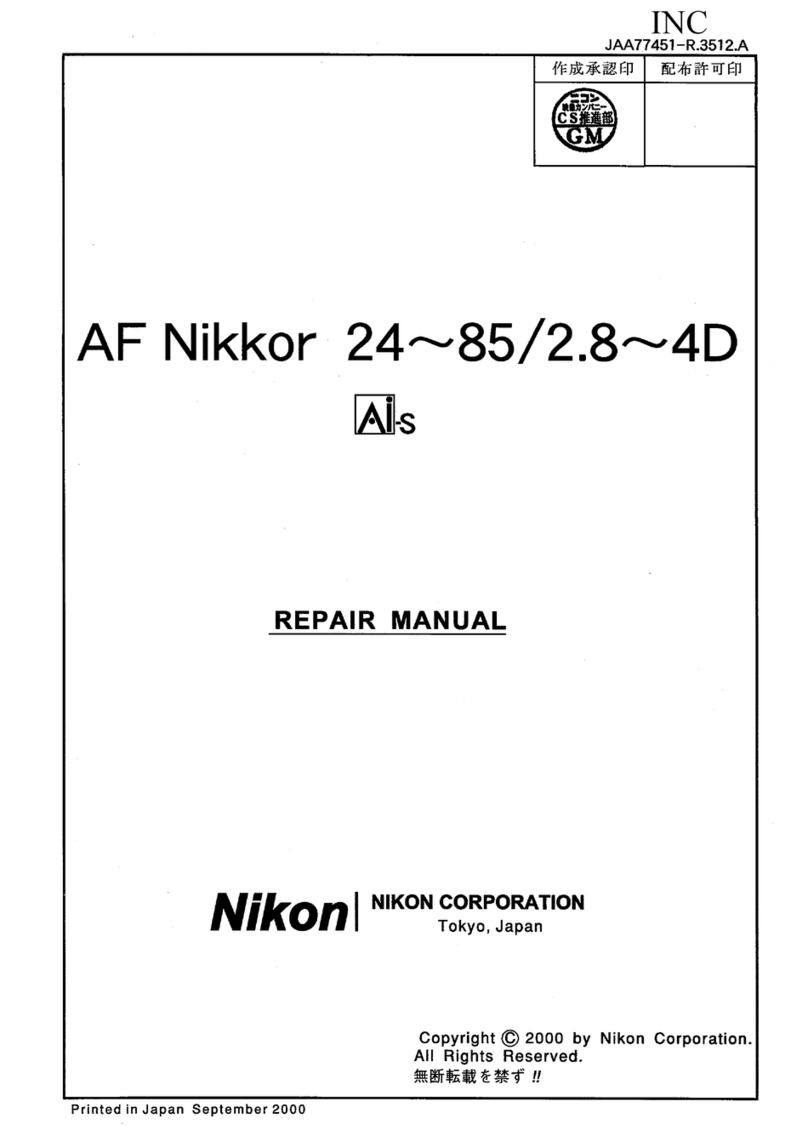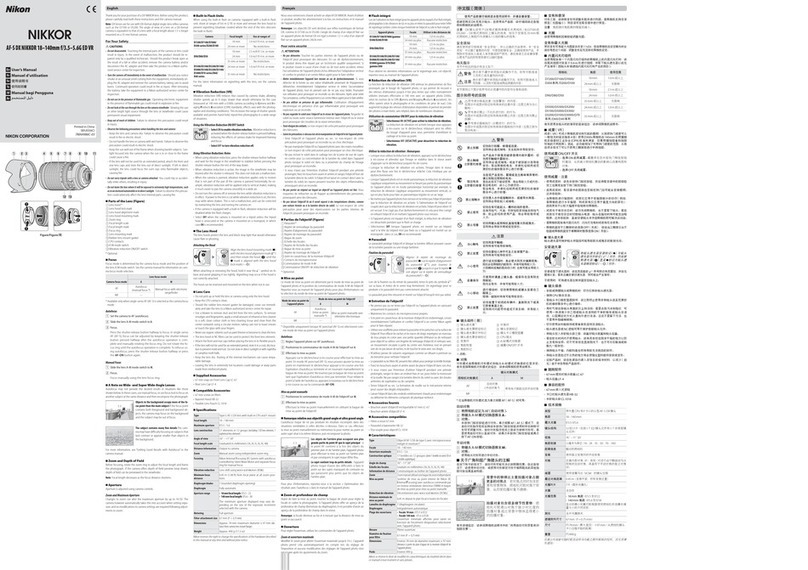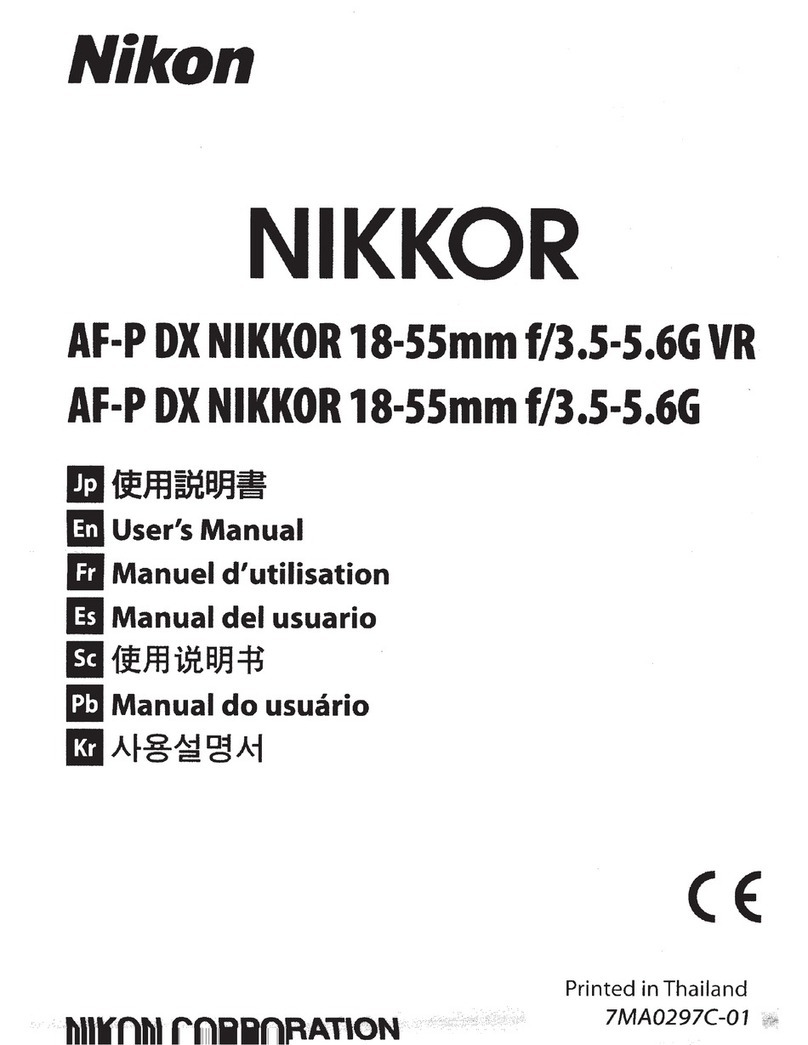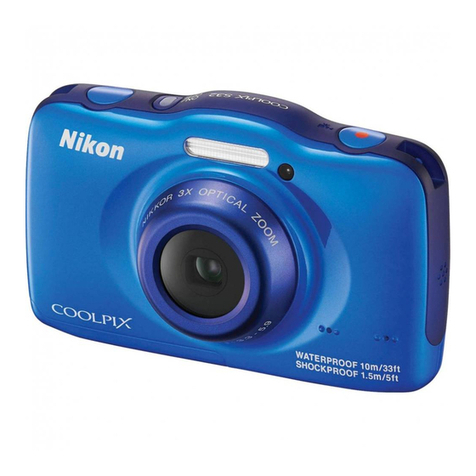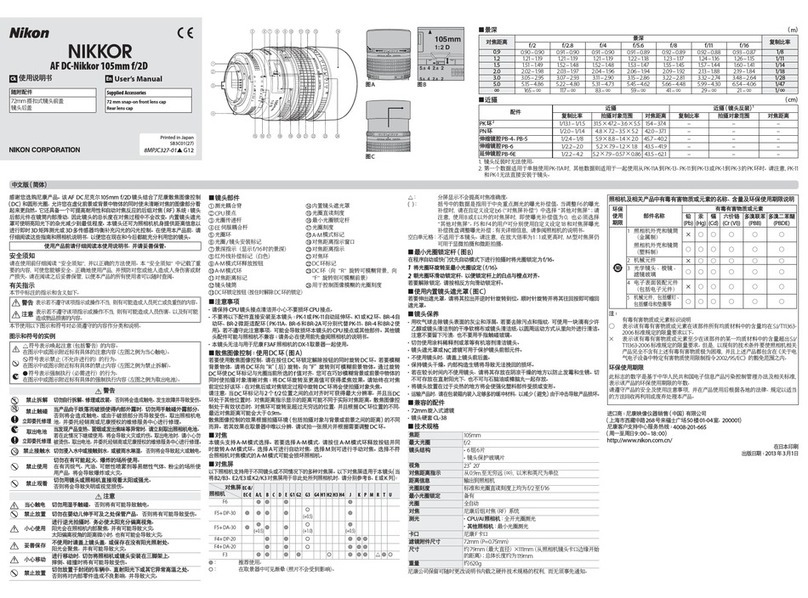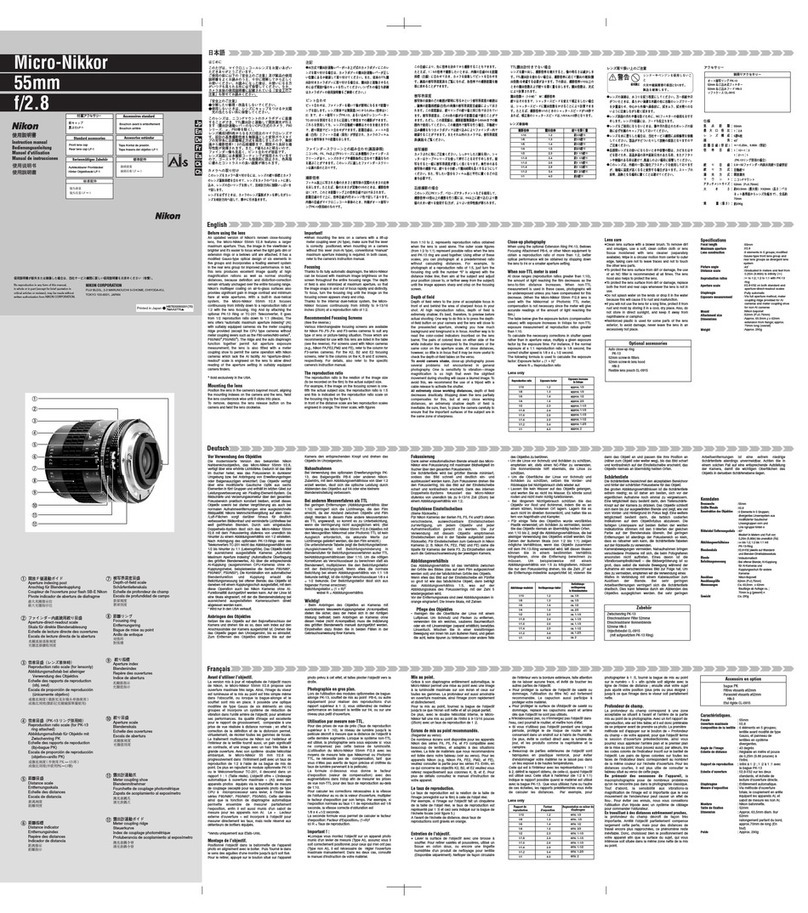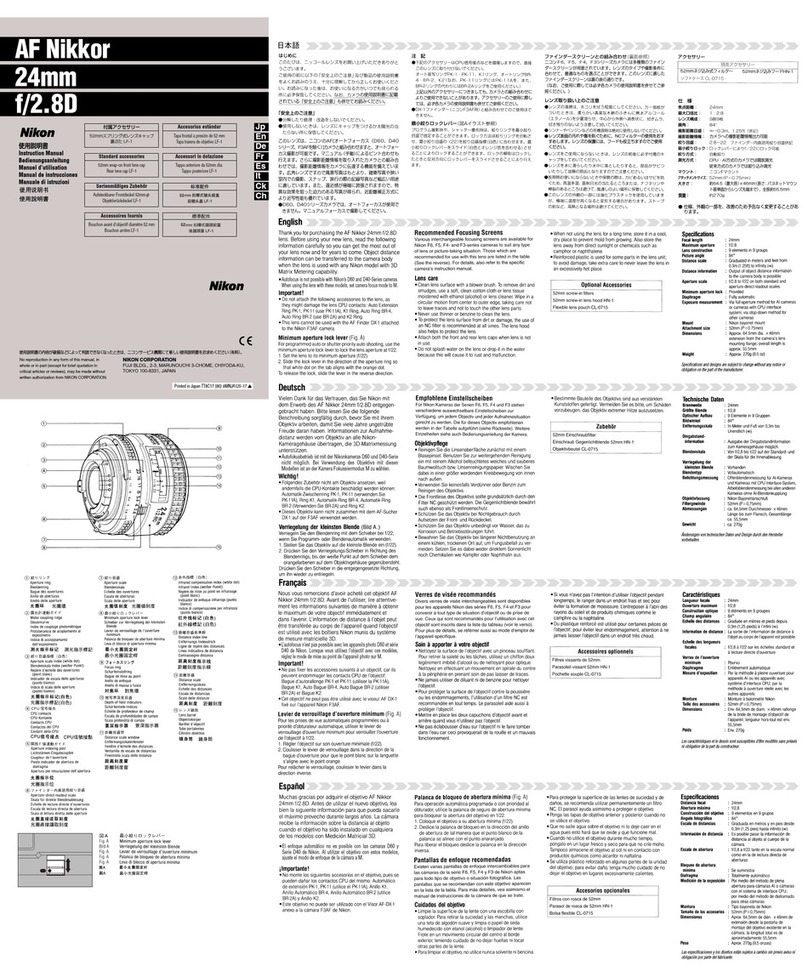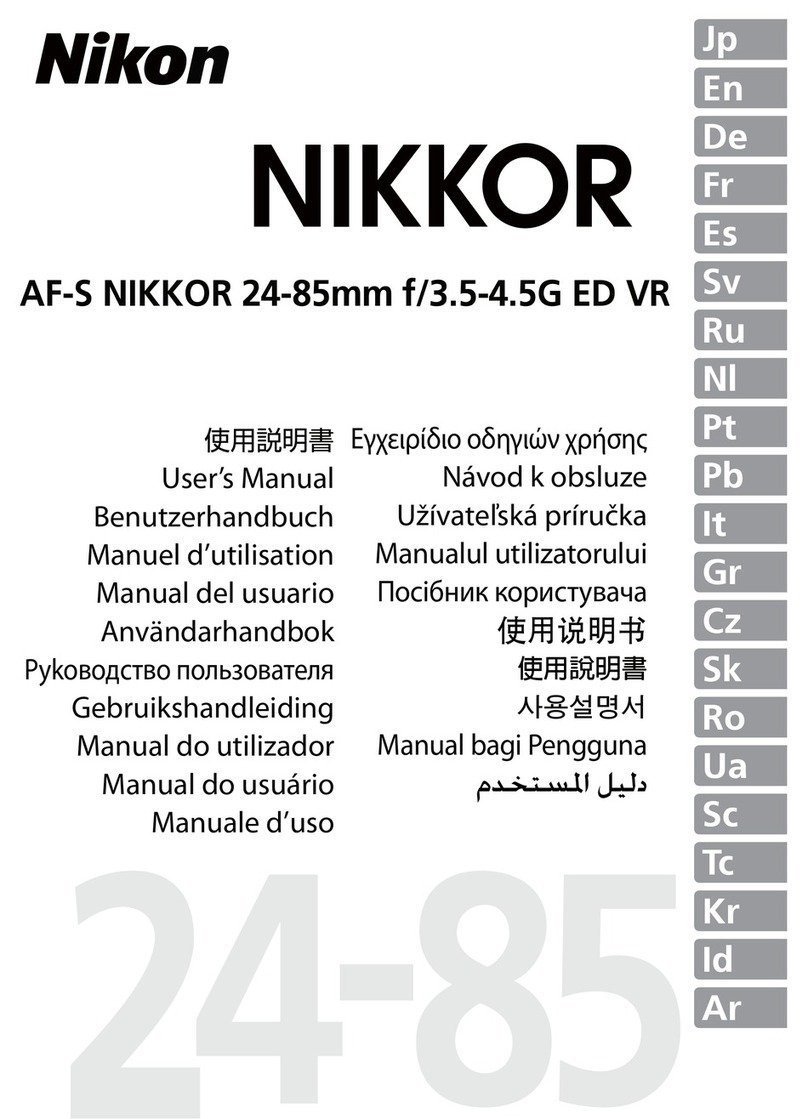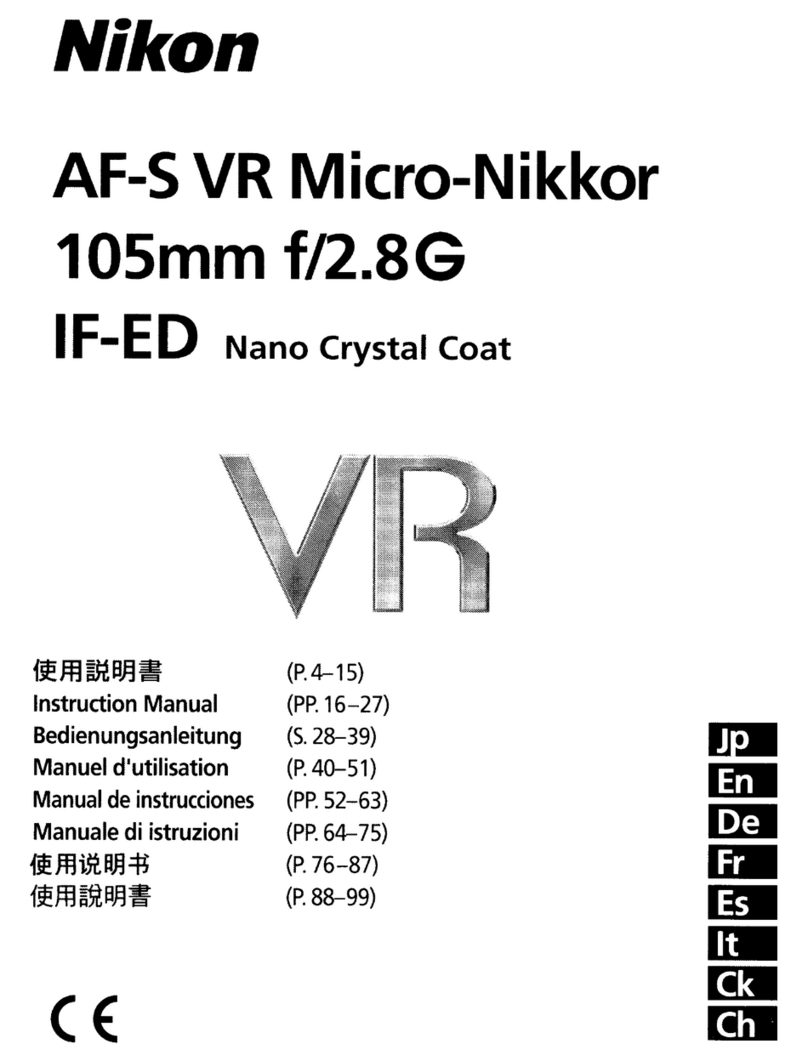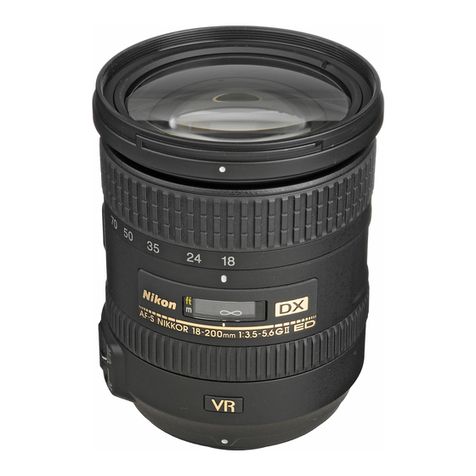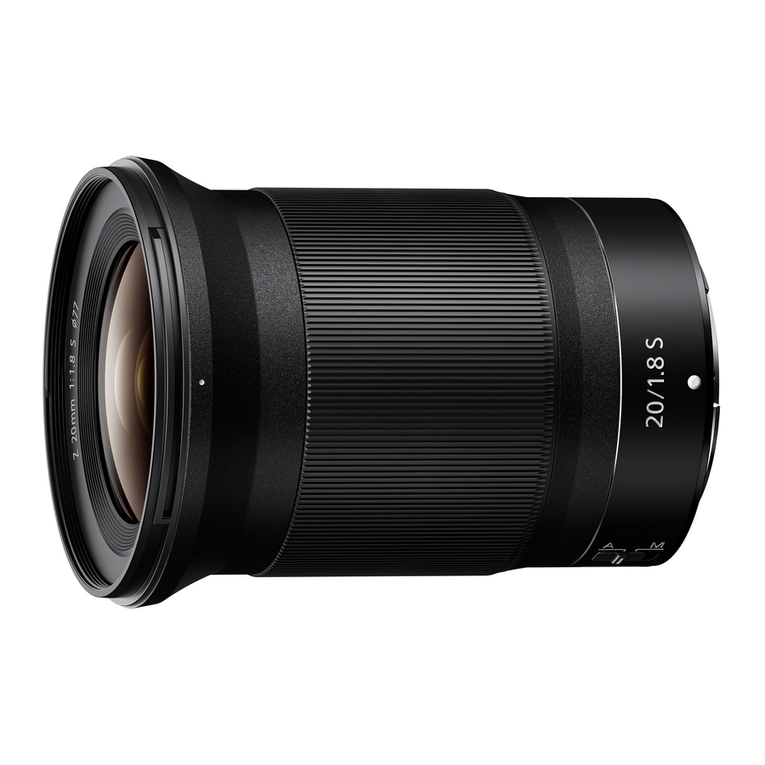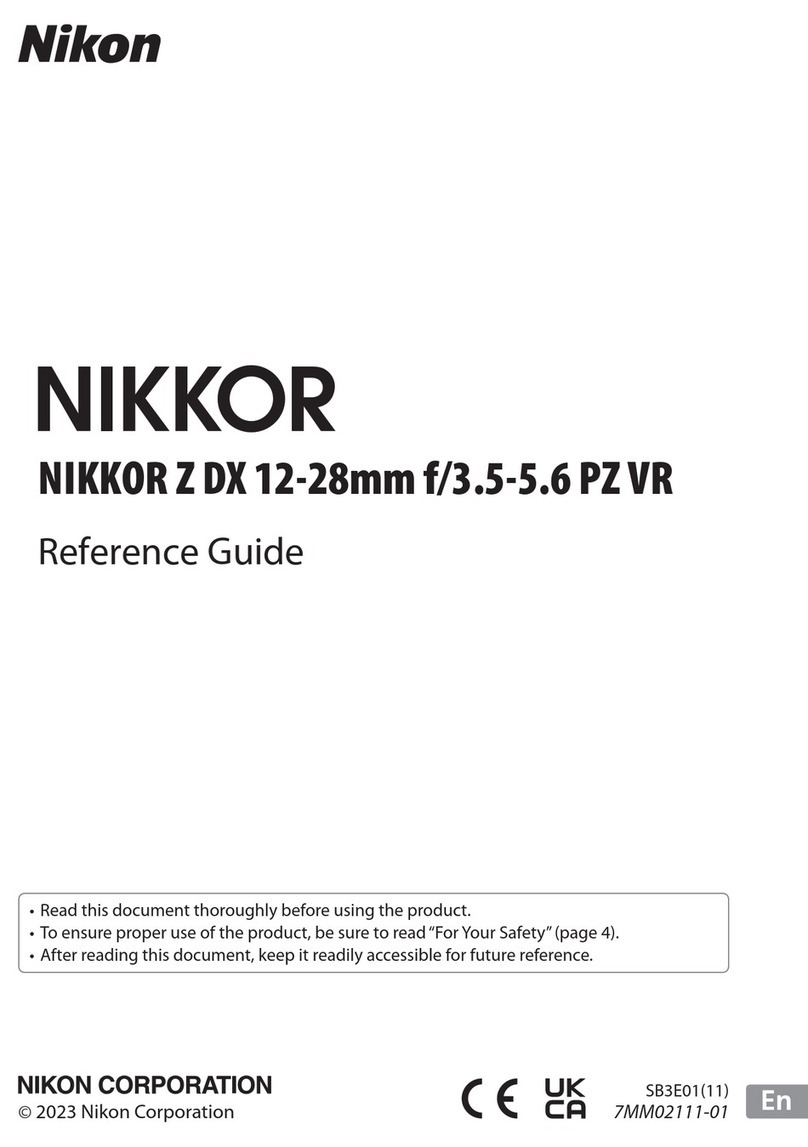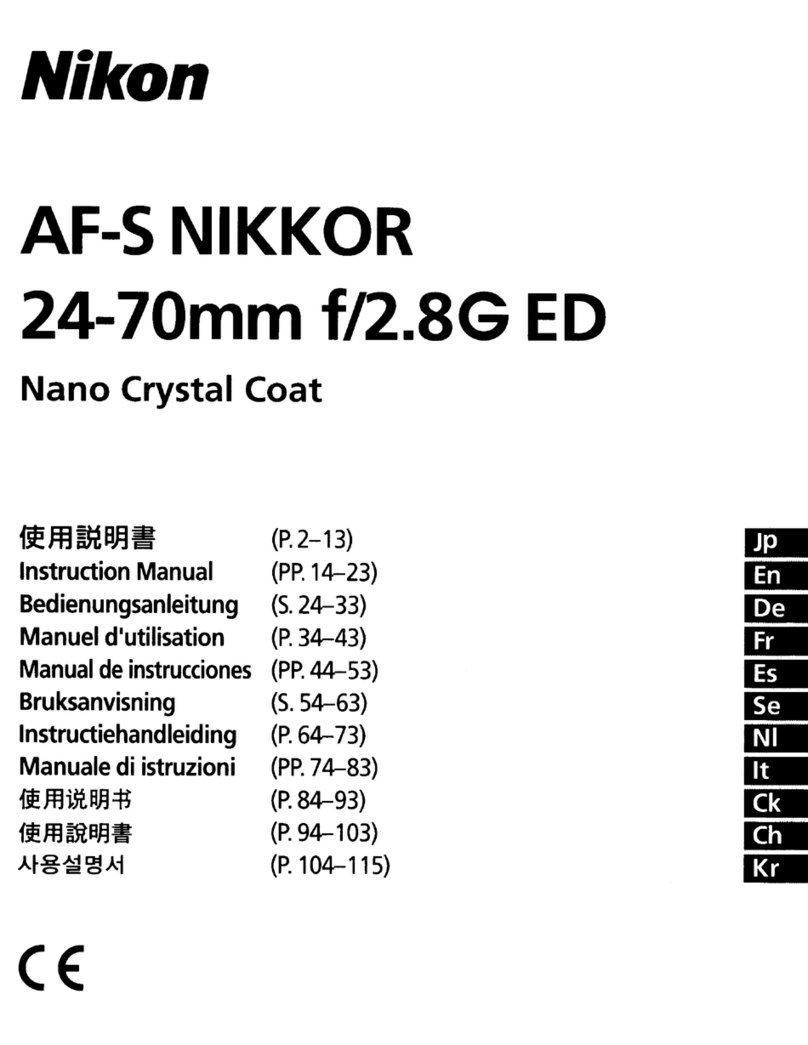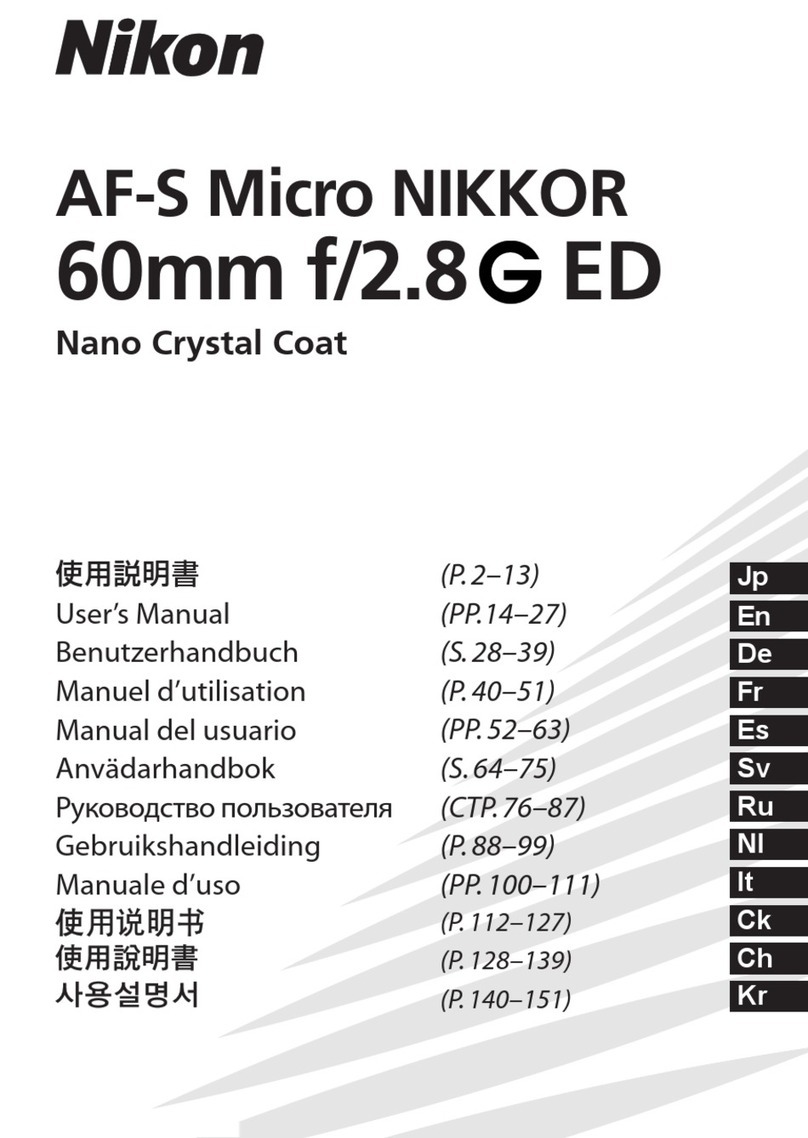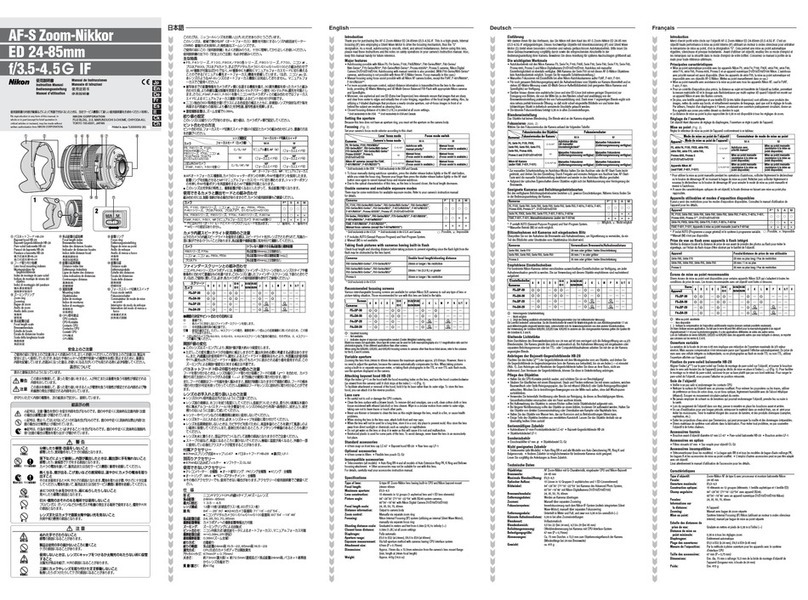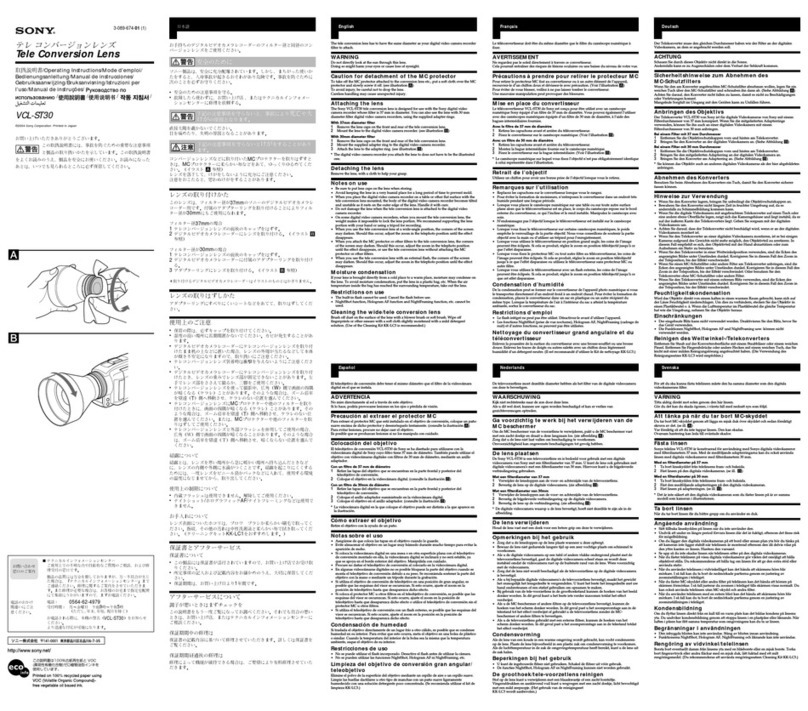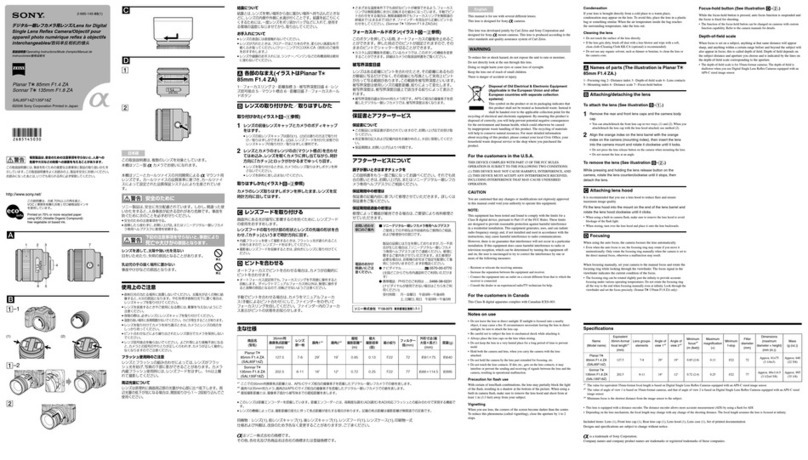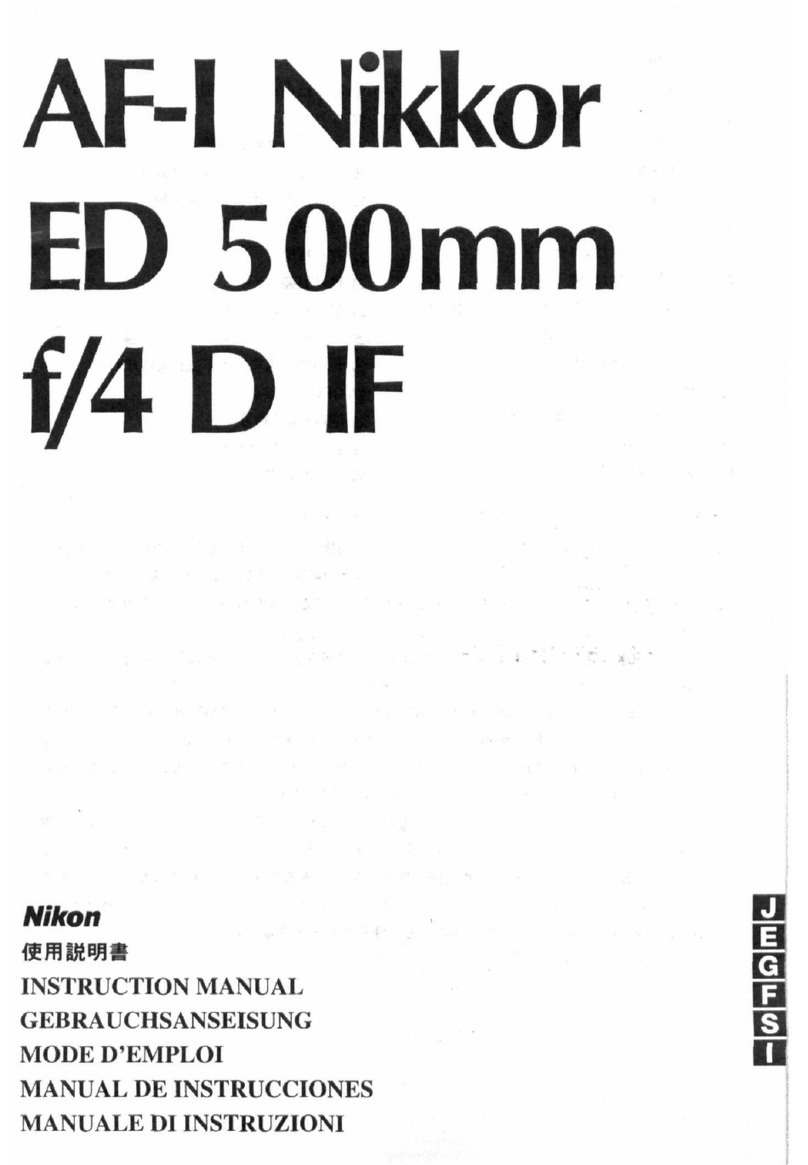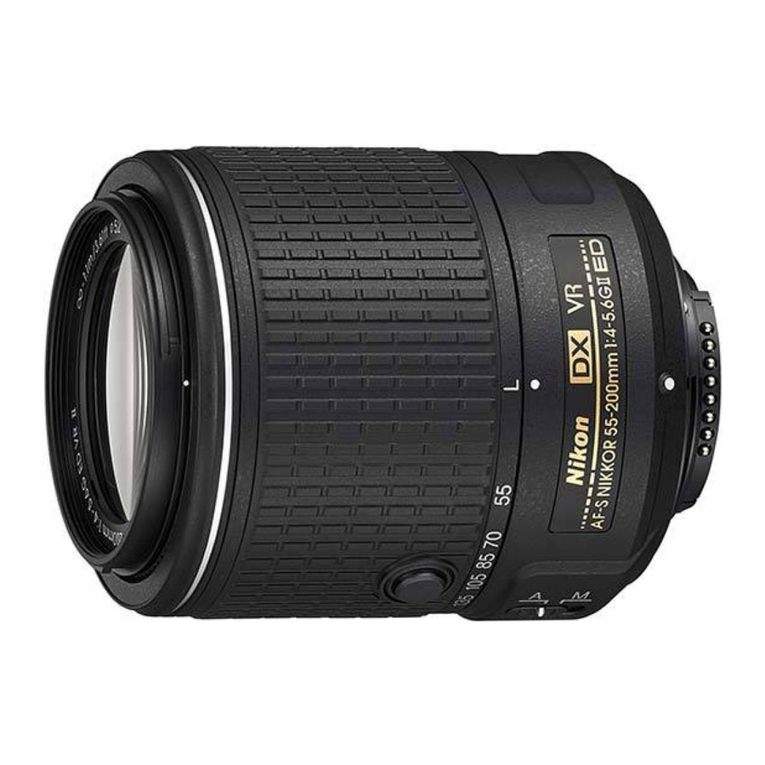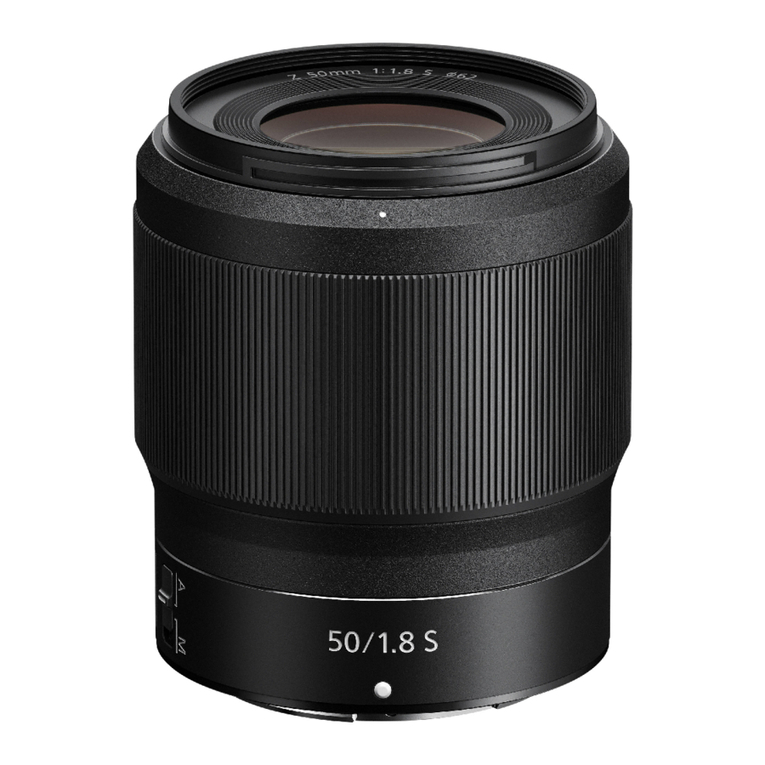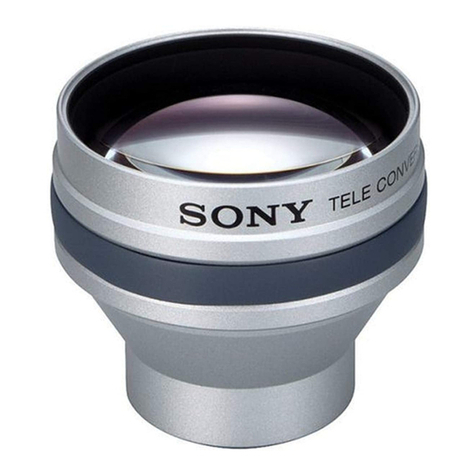
©1996 Nikon Corporation
English
22
16
11
5.6
200
12
4 3 2 1.8 M2.55710m ∞10 8 7 6152030ft
135
105
80
Thank you for your purchase of an AF Zoom-Nikkor 80–200mm f/2.8D. Before using this product,
please carefully read both these instructions and the camera manual so you can get the most out
of your lens now and for years to come.
This lens supports autofocus when used with Nikon autofocus cameras (F3AF excluded). It can
also be used for manual focus. Mounted on a compatible camera, it supplies subject distance in-
formation to the camera body. Featuring Nikon Integrated Coating (NIC), a wideband, multi-layer
anti-reection coating that keeps are and ghosting to a minimum for improved contrast, it is
ideal for portraits, sporting events, and, when mounted on a tripod using the tripod collar, night
photography.
CAUTIONS
• Do not disassemble. Touching the internal parts of the camera or lens could result in injury. In the event of
malfunction, the product should be repaired only by a qualified technician. Should the product break
open as the result of a fall or other accident, remove the camera battery and/or disconnect the AC adapter
and then take the product to a Nikon-authorized service center for inspection.
• Turn the camera o immediately in the event of malfunction. Should you notice smoke or an unusual smell com-
ing from the equipment, immediately unplug the AC adapter and remove the camera battery, taking care
to avoid burns. Continued operation could result in fire or injury. After removing or disconnecting the
power source, take the equipment to a Nikon-authorized service center for inspection.
• Do not use in the presence of ammable gas. Operating electronic equipment in the presence of flammable gas
could result in explosion or fire.
• Do not look at the sun through the lens or the camera viewnder. Viewing the sun or other bright light source
through the lens or viewfinder could cause permanent visual impairment.
• Keep out of reach of children. Particular care should be taken to prevent infants from putting the batteries or
other small parts into their mouths.
• Observe the following precautions when handling the lens and camera:
-Keep the lens and camera dry. Failure to observe this precaution could result in fire or electric shock.
-Do not handle the lens or camera with wet hands. Failure to observe this precaution could result in
electric shock.
-Keep the sun well out of the frame when shooting backlit subjects. Sunlight focused into the camera
when the sun is in or close to the frame could cause a fire.
-If the lens will not be used for an extended period, attach the front and rear lens caps and store the lens
out of direct sunlight. If left in direct sunlight, the lens could focus the sun’s rays onto flammable objects,
causing fire.
Parts of the Lens
qAperture/mounting index
wMinimum aperture lock lever
eAperture scale
rMinimum aperture signal post (EE servo coupling post)
tAF coupling
yAperture indexing post
uAperture-direct-readout scale
iCPU contacts
oMeter coupling ridge
!0 Aperture ring
!1 Tripod collar
!2 Tripod collar lock screw
!3 Tripod collar mounting mark
!4 Focal length mark/tripod collar mounting mark
!5 Focal length scale
!6 Zoom ring
!7 A-M mode index
!8 Macro range indicator (orange)
!9 Depth-of-eld indicators
@0 Focus distance indicator
@1 Infrared compensation index (white)
@2 Focus distance
@3 Focus limit switch
@4 A-M mode ring
@5 A-M mode ring release button
Notices
• Keep the CPU lens contacts clean and be careful not damage the CPU contacts.
• Do not attach the following accessories directly to the lens: PK-1 or PK-11 auto extension rings, BR-4 auto
rings, or K1 rings (the PK-11A and BR-6 or BR-2A can be used in place of the PK-11 and BR-4, respectively).
Failure to observe this precaution will result in damage to the CPU contacts or other parts of the lens.
Other lens accessories may not be compatible with the camera; be sure to consult the camera manual
before use.
• When the lens is attached to certain models of camera and then mounted on a tripod or monopod,
your fingers may inadvertently contact the tripod head the camera is rotated 90° to the right so that the
shutter-release button is at the bottom right corner. The tripod collar prevents this by rotating only coun-
terclockwise; do not attempt to rotate the collar clockwise.
• The lens can not be used with the DX-1 viewfinder for Nikon F3AF cameras.
Focus
This lens supports A-M mode selection. To choose the A-M mode, rotate the A-M mode ring
while pressing the A-M mode ring release button. Select Afor autofocus and Mfor manual focus.
Autofocus is not supported with close-up attachment lenses; select Mwhen using a close-up at-
tachment lens. Note that selecting Mwhen the lens is mounted on a Nikon N2020 (sold in the U.
S. A. and Canada only) or F-501 may cause the camera to malfunction.
This lens supports A-M mode selection. To choose the A-M mode, rotate the A-M mode ring while
pressing the A-M mode ring release button. Select Awhen the camera is in autofocus mode; when
the camera is in manual focus mode, select Mand focus by rotating the focus ring until the image
on the viewnder screen is no longer blurred (because the eective focal length may vary when
the lens is exposed to extremes of heat or cold, the focus ring is designed to turn slightly past both
M and innity). Supported focus modes are shown in the following table (for information on cam-
era focus modes, see the camera manual). Note that selecting Mwhen the lens is mounted on a
Nikon N2020 (sold in the U. S. A. and Canada only) or F-501 may cause the camera to malfunction.
M
AAutofocus Not usable Not usable
MNot usable Manual focusing Manual focusing
Zoom
Rotate the zoom ring to adjust the focal length and frame the photograph. For pin-point focus,
focus with the lens at the 200 mm zoom position and then zoom out to the desired focal length.
The Focus Limit Switch
For faster focusing, slide the focus limit switch from FULL to LIMIT. At short focus distances, select-
ing LIMIT will restrict focus to distances in the vicinity of 0.3 m to M, while selecting LIMIT at longer
focus distances will restrict focus to positions between approximately 3 m and ∞.
Macro Photography
Normally, the lens focuses at distances of from innity to 1.8 m, but it can be focused at distances
as short as 1.5 m at any focal length simply by rotating the focus ring past the 1.8 m mark. An
orange line will appear in the focus distance indicator window. At the minimum focus distance
and a focal length of 200 mm, the reproduction ratio is 1 : 5.9, while at 80 mm the reproduction
ratio is 1 : 14.
The Infrared Compensation Mark
The Infrared Compensation Mark
Compensation from distance index line
Compensation from distance index line
(on focus distance scale)
(on focus distance scale)
80 mm 428’ 3.39 mm
105 mm 221’ 1.78 mm
135 mm 115’ 0.95 mm
200 mm 031’ 0.39 mm
The Minimum Aperture Lock Lever (Figure A)
The Minimum Aperture Lock Lever (Figure A)
Lock aperture at f/22 when shooting in programmed auto or shutter-priority auto mode.
1Rotate the aperture ring to the minimum aperture setting (f/22).
2Slide the lock lever toward the aperture ring so that the white dot on the lock lever aligns
with the orange dot.
To release the lock, slide the lever in the opposite direction.
Focusing Screens
The cameras in the “Focusing Screens” table support a variety of focusing screens for use with
dierent lenses or in dierent situations.The screens listed in the table are suited for use with this
lens.
When using B2/B3, E2/E3, or K2/K3 screens with cameras not listed in this table, refer respectively
to columns B, E, or K.
H1
F6
F5+ DP-30
{
(+0.5)
F5+ DA-30
(+0.5)
{
F4+ DP-20
(-1.0)
F4+ DA-20 {
(-0.5)
F3 { {
F
F6
F5+ DP-30
F5+ DA-30
(+0.5)
F4+ DP-20
F4+ DA-20
F3 {{ U
: Recommended.
{: Vignetting visible in viewfinder (photographs are not affected).
U: Split-screen display does not improve focus accuracy.
( ): Figures in parentheses give the exposure compensation for center-weighted metering. Select
“Other screen” for Custom Setting b6 (“Screen comp.”) when adjusting exposure compensation
for the F6; note that with screens other than B or E,“Other screen”must be selected even when the
value for exposure compensation is 0. Users of the F5 and F4 can adjust exposure compensation
using Custom Setting 18 or the focusing screen exposure compensation dial, respectively; see the
camera manual for details.
Empty cell: Not suited to use with this lens. Note that type M screens can however be used for photomicrog-
raphy and macro photography at magnifications of 1 : 1 or higher.
Lens Care
• Use a blower to remove dust and lint from the lens surfaces. To remove smudges and fingerprints, apply
a small amount of ethanol or lens cleaner to a soft, clean cotton cloth or lens-cleaning tissue and clean
from the center outwards using a circular motion, taking care not to leave smears or touch the glass with
your fingers.
• A lens hood or NC filter can be used to protect the front lens element.
• Attach the front and rear caps when the lens is not in use.
• Keep the lens dry. Rusting of the internal mechanism can cause irreparable damage.
• If the lens will not be used for an extended period, store it in a cool, dry location to prevent mold and rust.
Do not store in direct sunlight or with naphtha or camphor moth balls.
• Leaving the lens in extremely hot locations could damage or warp parts made from reinforced plastic.
Compatible Accessories
• 77 mm screw-on filters
• Bayonet Hood HB-7
Focal length 80 mm – 200 mm
Lens construction 16 elements in 11 groups
Angle of view 30°10ಿ– 12°20ಿ
Focal length scale Graduated in millimeters (80, 105, 135, and 200)
Distance information Output to camera
Zoom Manual zoom using independent zoom ring
Macro focus Macro focus is available at all focal lengths; minimum focus distance is
1.5m; maximum reproduction ratio is 1 : 5.9
Focus distance indicator Graduated in meters and feet from 1.8 m to infinity (∞), 1.5 m to 1.8 m in
macro focus mode
Focus limit switch ∞–M (1.5 m), ∞–3 m, 2.5 m–M (1.5 m)
Aperture scale f/2.8–f/22 on both standard and aperture-direct-readout scales
Minimum aperture lock Provided
Infrared compensation indices
Infrared compensation indices Two white dots are provided at the 80 mm focal length
Diaphragm Fully automatic
Metering • CPU/AI cameras: Full aperture
• Other cameras: Minimum aperture
Mount Nikon bayonet mount
Filter-attachment size 77 mm (P = 0.75 mm)
Tripod mount Built-in tripod collar rotatable through 290°
Dimensions Approx. 87 mm maximum diameter × 187 mm (distance from camera lens mount
ange); overall length is approx. 195mm
Weight Approx. 1300 g (2.9 lb)
Nikon reserves the right to change the specifications of the hardware described in this manual at any time and
without prior notice.
Figure A Minimum aperture lock lever
A
Depth-of-field scale
B
Subject-distance scale
Focal length (mm)
